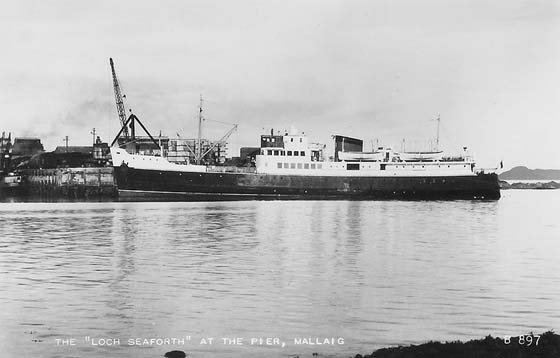
One report records that the ship had but one drawback, her Sulzer engines, which were reported as 'making an appalling noise'. It is perhaps ironic that two of the ship's ports of call, Kyle of Lochalsh & Mallaig provided a rail connection to the MacBrayne services and from the early 1960's these services employed locomotives also powered by Sulzer six cylinder engines - did these also 'make an appalling noise'?
The renewal of the mail contract in 1938 to David MacBrayne Ltd stipulated the use of two new ships, one for the service to Stornaway, the other for the Islay service. Both would be larger than any in the existing fleet, with the first, the MV Lochiel entering service to Islay in 1939, the construction of the second was delayed due to World War II and shortages following the end of hostilities. William Denny & Brothers of Dumbarton received the order late in 1945 and the ship was launched on May 19th 1947. The new vessel was named after the passage of water between Lewis & Harris - Loch Seaforth was intended for service between Mallaig, Kyle & Stornaway. The steam powered Lochness although built only in 1929 was already too small for traffice on this route.
The Loch Seaforth would be the largest of the MacBrayne fleet until the arrival in 1964 of the newer car carrying vessels.
The design of the ship carried over some elements from the previously mentioned Lochness. Externally similar were the forecastle, the shadedeck and the cruiser stern. Inside the passenger accommodations were much improved, even at the third class level. Both the first & third class passengers had cubicles and sleeping cabins. All cargo space was forward and the foremast incorporated two derricks. Space was available for sixteen cars. Four lifeboats were carried.
In a hearkening back to earlier times the bow of the ship sported an image of the MacBrayne Highlander 'figurehead', a symbol which could be found in MacBrayne's advertising and publicity material.
In 1949 the funnel, originally quite short was lengthened by the depth of the black top.
About six months after launching the Loch Seaforth commenced service on the 'Stornoway Mail Service' from Stornoway on December 6th 1947, quickly becoming very popular. The 12.15am sailing (previously 11.45pm) still allowed the mail train connections to be made at Kyle and Mallaig.
Until 1956 the Loch Seaforth also made an outward stop at Applecross, this changed with the arrival of the Loch Toscaig. Later from 1959 - 1953 the Loch Seaforth provided occasional car ferry service between Mallaig & Armadale.
In December 1965 the Loch Seaforth grounded at Mallaig harbour, sustaining enough damage to require a visit to the Clyde for an early annual overhaul. Then early in March 1966 a minor collision with a pile at Mallaig harbour caused a plate to be strained; the troubles continued the next day when she grounded at Kyle. The tide left her high and dry on the reef for two days. Her master was later disciplined and suspended for two months.
On October 22nd 1971 the Loch Seaforth hit the island of Longay, off Broadford. The passengers were rescued by Bruce Watt's launch Western Isles which happened to be passing.
During January 1972 the Loch Seaforth was withdrawn from the Stornoway route and transferred to the Oban - Coll - Tiree - Castlebay - Lochboisdale sailing, in place of the newer Claymore. A minor similarity between the Claymore and the Loch Seaforth was that they were both powered by Sulzer engines. There was a brief return to Stornoway after a collision damaged the Clansman. This was a brief respite, by May 28th 1972 she was back on the 'Inner Isles Mail', which now included a stop at Colonsay.
The beginning of the end for the Loch Seaforth occurred at about 6.00am on March 22nd 1973 when she ran aground on Cleit Rock in the Sound of Gunna which separates Coll and Tiree. The ship had been holed below the engine room and was taking on water fast. The order was given to abandon ship with distress calls being sent out. A ship's lifeboat was used to safely evacuate the passengers and crew. Once ashore the ship's Master, Captain Gunn observed the ship was still afloat and asked for volunteers to return to the ship in an attempt to save it. The entire crew volunteered but only a skeleton crew went out to the ship, joined by a tug responding to the distress call. The Loch Seaforth was able reach to Gott Bay, Tiree, for inspection, eventually tying up at Scarinish Pier.
A skeleton crew remained with the ship whilst technical staff were called in to evaluate the ship's condition. Its condition worsened overnight when a bulkhead collapsed, flooding another compartment and causing the ship to settle on the seabed. This blocked Tiree's only pier leading to considerable disruption. For weeks neither cattle nor vehicles could be loaded from Tiree, no doubt to the consternation of the locals.
The ship was declared a total loss and remained there for about seven weeks until on May 11th 1973 the giant floating crane, the Magnus III arrived from Southampton to raise the mailboat. The ship was dumped on the beach, patched up, refloated and towed down to Troon for scrapping by the West of Scotland Shipbreaking Co. Ltd.
Built: William Denny and Brothers of Dumbarton, yard No. 1404
Launched: May 19th 1947
Tonnage: gross 1,126 tons
Length: 69.90 metres (229 ft 4 in)
Breadth: 11 metres (36 ft 1 in)
Draught: 3.40 metres (11 ft 2 in)
Propulsion: Two x 6-cylinder Sulzer Bros Ltd Winterthur two-stroke diesel engines, 1,800 bhp at 235 rpm
Screws: two 3-blade propellors
Speed: 15 knots
Home port: Glasgow
Page added September 10th 2010.
Return to Ship menu
Return to site menu